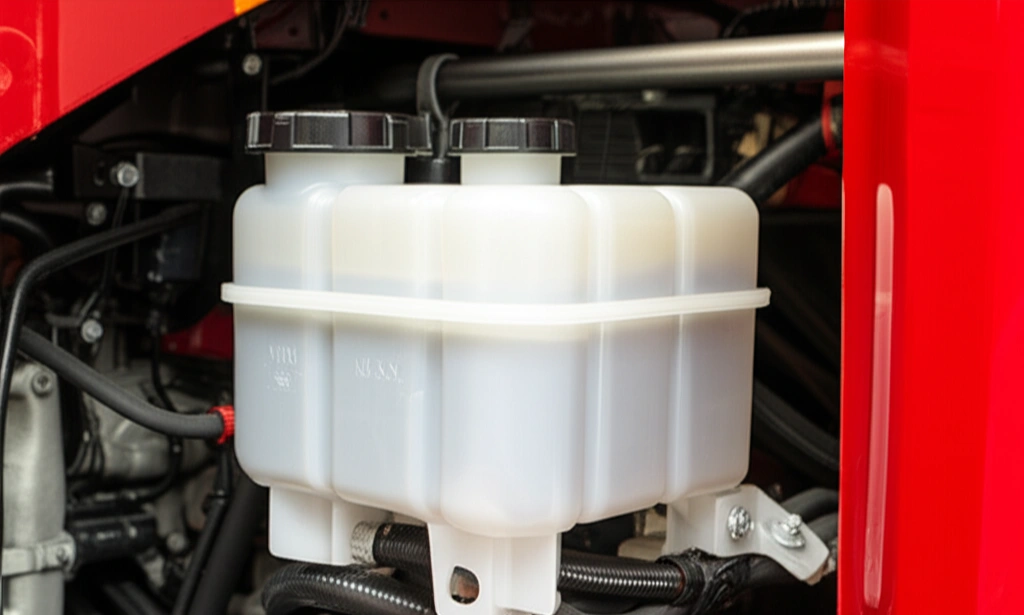
More Than a Plastic Box A Deep Dive into Coolant Tanks as Vital Truck Body Parts
The American highway in the heat of summer is a proving ground. For a heavy-duty truck, the battle against heat is constant. A fully loaded diesel engine generates an astonishing amount of thermal energy, enough to heat a home in the winter. The only thing standing between that immense heat and catastrophic engine failure is the cooling system. While we often focus on the radiator or water pump, the visible command center of this entire system is a component that is critically integrated with the vehicle’s structure: the coolant tank.
Though fundamentally part of the cooling system, the Coolant Tanks on modern trucks are best understood as essential Truck Body Parts. They are bolted directly to the firewall, inner fender, or radiator support—key structural elements of the truck’s body. Their shape, durability, and mounting points are just as much about chassis integration as they are about holding fluid. At the American, we produce spare parts designed to withstand the immense stress placed on every component of a rig, and we know that a failure in a seemingly simple part like a coolant tank can have consequences for the entire vehicle.
This guide will take a deep dive into the world of truck coolant tanks. We’ll explore what they do, how they fail, and why choosing a high-quality replacement is one of the most important investments you can make in your truck’s longevity and reliability.
The Unsung Hero What Does a Coolant Tank Actually Do?
At first glance, a coolant tank—also known as a degas bottle, surge tank, or expansion tank—seems to have one simple job: hold the coolant. In reality, it performs four distinct and critical functions that are essential for a modern, high-performance diesel engine.
1. Managing Thermal Expansion: This is its primary purpose. As your engine reaches its operating temperature of nearly (`), the coolant inside it heats up and expands significantly in volume. Without a place for this expanded fluid to go, the pressure inside the cooling system would skyrocket, bursting radiator hoses, blowing out seals, or even cracking the radiator itself. The coolant tank provides the necessary empty air space, or “headspace,” to safely accommodate this expansion. The “MIN” and “MAX” lines on the side of the tank are calibrated to ensure there’s enough room for this process.
2. De-aeration (Removing Air): Air is a terrible conductor of heat and the enemy of an efficient cooling system. Air bubbles can get trapped in the system, leading to “hot spots” in the engine—particularly around the cylinder heads—where the lack of liquid coolant can cause temperatures to spike dangerously. The coolant tank is designed to act as a de-aeration, or “degas,” chamber. As coolant circulates, it passes through the tank, allowing any trapped air bubbles to rise to the top and separate from the liquid, ensuring the engine block is filled only with pure, efficient liquid coolant.
3. Acting as a Reservoir and Fill Point: The tank serves as the main reservoir for the entire system. It’s the highest point, making it the logical and safest place to check the coolant level and add fluid when necessary.
4. Pressurizing the System: The cap on your coolant tank is not just a lid. It is a precisely engineered pressure-relief valve. It’s designed to hold a specific amount of pressure in the system (typically psi`). By pressurizing the system, the cap raises the boiling point of the coolant by a significant margin. This allows the engine to operate safely at temperatures above the normal boiling point of water, which is essential for efficiency and emissions control, without the risk of the coolant boiling over.
The Anatomy of Modern Coolant Tanks
The design and material of coolant tanks have evolved significantly. While older trucks may have used metal tanks, virtually every modern American truck uses a tank molded from high-grade, heat-resistant plastic. This is where its role as a “Truck Body Part” becomes clear.
- Molded Plastic Body: Modern tanks are typically made from virgin-grade polypropylene or glass-filled nylon. This offers several advantages over metal: it’s completely resistant to corrosion, it’s lightweight, and it can be blow-molded into complex, intricate shapes. This allows engineers to design tanks that fit perfectly into the tight confines of a modern engine bay. The translucent nature of the plastic also provides the huge benefit of being able to see the coolant level at a glance.
- Integrated Mounting Points: A coolant tank isn’t just sitting in the engine bay; it is rigidly mounted. The molding process allows for the integration of robust mounting brackets, tabs, and bolt holes directly into the tank’s body. These points are used to secure the tank to the truck’s firewall, radiator core support, or inner fender structure. The strength of these mounts is critical, as they must endure constant engine vibration for hundreds of thousands of miles. A failure of these mounts is a failure of the part.
- Hose Nipples and Ports: The tank will have several hose connections molded into it. These include a large inlet/outlet for the main coolant flow, a smaller nipple for an overflow or vent line to the radiator, and sometimes other ports for heater cores. The durability of these plastic nipples is crucial, as they become brittle with age and can easily crack or snap off during service.
- Pressure Cap Neck: The flange where the pressure cap twists on is one of the most critical surfaces. It must be perfectly flat and round to create an airtight seal with the cap’s gasket. Over time, heat can cause this neck to warp, preventing the system from holding pressure and leading directly to overheating problems.
- Embedded Level Sensor: Many modern tanks feature an integrated electronic coolant level sensor. This sensor is built directly into the tank and will trigger a warning light on the dashboard if the coolant level drops below a safe point. This provides a vital early warning of a leak somewhere in the system.
Why They Fail The Inevitable Crack
Despite being designed for durability, the coolant tank is a part that will almost certainly need to be replaced over the life of a truck. It lives in one of the harshest environments imaginable, subject to extreme temperature swings, constant vibration, and chemical exposure.
- Heat Cycles and Fatigue: This is the number one killer of plastic coolant tanks. Every time the engine heats up and cools down, the plastic expands and contracts. After thousands of these cycles, the plastic loses its flexibility and becomes brittle. This is why older tanks often have a yellowed, hazy appearance. This brittleness eventually leads to stress cracks, often forming along the seams or at the mounting points.
- Vibration: Constant vibration from the engine and road puts immense stress on the mounting brackets and hose nipples. This can cause fatigue fractures to form, leading to leaks.
- Chemical Degradation: Using the wrong type of coolant, a universal “all-makes” coolant that isn’t approved for your engine, or topping off the system with plain water can chemically attack the plastic over time, weakening it from the inside out.
- Failed Pressure Cap: If the pressure cap fails and does not vent at its specified pressure, the entire cooling system can become over-pressurized. The coolant tank is often the weakest link in the chain and will swell or split at its seam under this extreme pressure.
The Dangerous Ripple Effect
A leaking coolant tank might seem like a minor annoyance, but it’s a ticking time bomb. The initial leak leads to a drop in coolant level. This drop allows air to be sucked into the system, creating air pockets that prevent proper heat transfer. These hot spots can lead to warped cylinder heads or, in the worst-case scenario, a blown head gasket—a repair that can cost thousands and result in significant downtime. A small leak from a cracked plastic tank can directly lead to catastrophic engine failure.
This is why you must treat a failing coolant tank with the urgency it deserves. At the first sign of a leak, a cracked mounting point, or a warped cap neck, replacement should be scheduled immediately.
An Essential Part, An Essential Choice
The coolant tank is a perfect example of a component whose importance far outweighs its perceived simplicity. As a core Truck Body Part, its structural integrity is just as vital as its ability to hold fluid. It is the guardian of your cooling system and, by extension, your entire engine.
Don’t let a small crack turn into a five-figure engine repair bill. When it comes time for a replacement, choosing a quality part is essential. At the American, we offer premium replacement Coolant Tanks built from high-grade, virgin materials to resist heat and vibration. Our tanks are molded to exact OEM specifications, ensuring that every mounting point, hose nipple, and sensor port aligns perfectly for a fast, leak-free installation. Protect your engine, protect your investment, and trust “the American” for the durable parts you need to keep your rig on the road.
You can visit our website for more detailed information.




